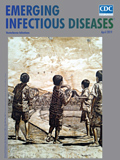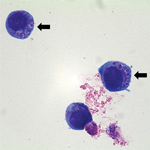
Volume 25, Number 4—April 2019
Etymologia
Etymologia: Anaplasma phagocytophilum

Figure. Anaplasma phagocytophilumcultured in human promyelocytic cells, showing morulae as basophilic and intracytoplasmic inclusions (arrows). Wright-Giemsa stain. Original magnification x1,000. Image: Emerg Infect Dis. 2014;20:1708–11.
A species of tickborne bacteria that causes human granulocytic anaplasmosis, Anaplasma (from the Greek an- [“without”] + plasma [“shape”]) phagocytophilum (named for its affinity for growing in neutrophils: phagocyte + Latin phile [“loving”]) has gone by many names (Figure). First it was named Rickettsia (for Howard Taylor Ricketts) phagocytophilum, then Cytoecetes (for its similarity to Cytoecetes microti) phagocytophilum, and then Ehrlichia(for Paul Ehrlich) phagocytophilum. More recently, E. equi and the agent of human granulocytic ehrlichiosis (now anaplasmosis) were combined with E. phagocytophilum as A. phagocytophilum.
References
Figure
Cite This ArticleOriginal Publication Date: 2/28/2019






















.png)











No hay comentarios:
Publicar un comentario